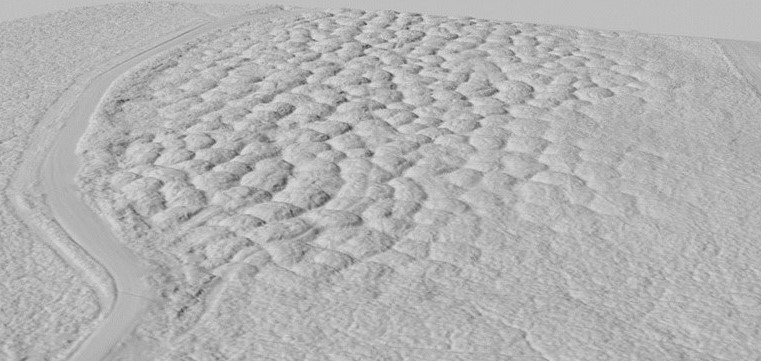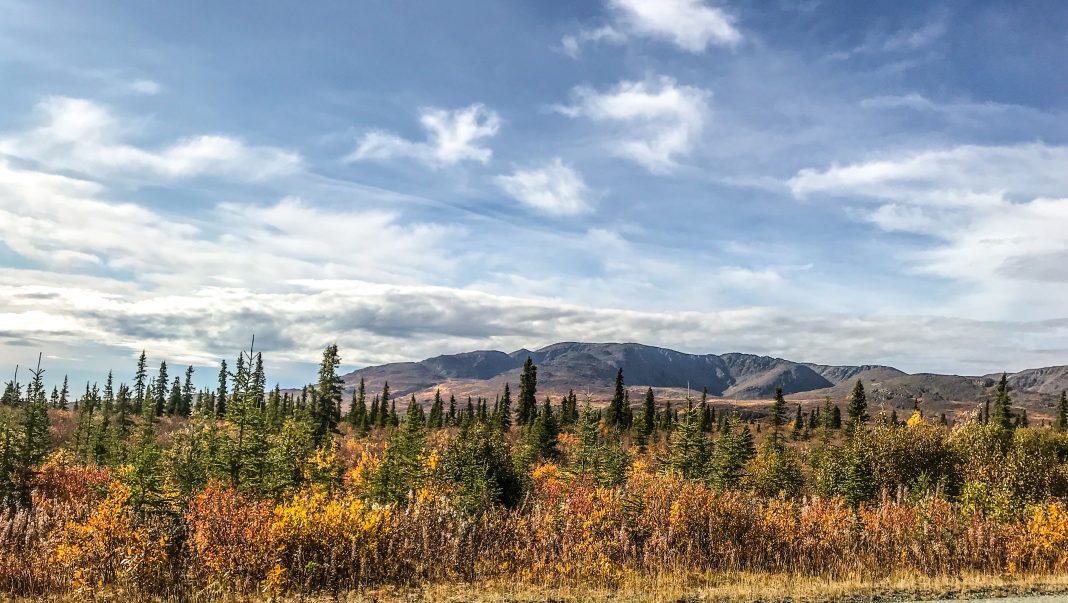Here, we learn about Dr. Melissa Ward Jones, who leads a transdisciplinary team of researchers at the University of Alaska Fairbanks, co-producing knowledge with farmers to understand these unique agricultural systems better
In 1908, a field was cleared for cultivation in Fairbanks, Alaska, at a U.S. Federal Agricultural Experiment Station (Pewe, 1954) that is now part of the University of Alaska Fairbanks (UAF). Cultivated potatoes crops provided good yields, however, ten years after land clearing, the field began to sink down and mounds, up to 10 m in diameter and up to 2.5 m high, began to appear (Rockie, 1942). After repeated grading and land leveling, the mounds continued to be redeveloped, leading to the field’s abandonment sometime in the 1920s. Today, this area is a forested walking trail on the UAF campus, and the mounds remain (Figure 1).
The development of these mounds resulted from thawing ice-rich permafrost (ground material that remains at or below 0 °C for two or more consecutive years).
Permafrost-agriculture interactions in Alaska
Permafrost is the foundation of high latitude and mountainous social-ecological systems, and its response to thaw largely depends on its ground ice content. These responses include simple increases in ground temperatures in ice-poor areas and subsidence, or sinking of the land surface, in areas with high ground ice content, as what occurred in the UAF potato field. While research has traditionally focused on the biophysical changes within permafrost systems, little is known of its effects on industries like agriculture.
Permafrost Grown research team
Permafrost Grown brings together a research team from UAF and Alaskan farmers to co-produce a better understanding of the interactions and feedbacks of agricultural systems within arable, permafrost-affected soils (henceforth termed permafrost-agroecosystems). Additional project objects include:
- Understanding the 120-year legacy effects of permafrost- agroecosystems in Alaska,
- Understanding the economic impacts and trade-offs that lead to diverse decision-making strategies and,
- Producing education and outreach materials and events to broaden participation and workforce development of farmers and the public.
This five-year, USD 3-million project is funded by the U.S. National Science Foundation’s Navigating the New Arctic Initiative.
Our team is transdisciplinary, with expertise in various aspects of permafrost sciences (Melissa Ward Jones, Benjamin Jones, Mikhail Kanevskiy, Yuri Shur, and Benjamin Gaglioti), high latitude agricultural sciences, and sustainable food systems (Glenna Gannon), natural resource economics (Tobias Schwoerer), soil sciences (Chien-Lu Ping and Daniel Stitch) and policy (Nicholas Parlato).
Our farmer-collaborators have participated since the project’s initial development and have been instrumental in developing our project research questions. Our collaborator-farmers span diverse ages, genders, farming experience, and lifetime experience in Alaska.
Permafrost Grown focuses on in-the-ground farming in various agricultural types, including crop cultivation, peonies, and animal husbandry. Understanding this range of permafrost-agroecosystem activities is essential as interactions between permafrost and livestock or between permafrost and different cultivars (annuals vs. perennials) will differ.
Our project methods include conducting surveys and interviews, a sensor network to measure weather and ground conditions, satellite-, airborne- and drone-based remote sensing, ground drilling, soil surveys, agricultural experiments, and economic modeling. We are tracking current and near-future subsidence rates with repeat drone mapping.
We are also reconstructing thaw histories using a combination of our LiDAR drone to map topography, drilling in the ground to determine the top of permafrost and coring trees that are leaning in response to thaw subsidence to date the onset of thaw and understand rates of permafrost degradation.
Through our agricultural experiments, we are assessing the permafrost thaw or mitigation potential of a range of mulch types. We recently completed the first summer of assessing 11 different mulch types, ranging from various plastics to biodegradable mulches like straw. We are also testing crop cultivars to find crops that can grow successfully in permafrost-affected soils and will grow in previously subsided and abandoned areas.

Alaska permafrost research priorities
Approximately 80% of Alaska is underlain by permafrost (Jorgenson et al., 2008). Therefore, research must be conducted to develop techniques and strategies specifically adapted to this unique environment rather than transpose techniques from southern latitudes (Ward Jones et al., 2022).
Permafrost Grown is filling in critical knowledge gaps promptly. Between 2012 and 2017, there was a 30% increase in farm numbers in Alaska while farms simultaneously declined by 3% in the continental U.S.. Permafrost Grown will help support a more adaptable, resilient, and sustainable agricultural sector in Alaska.
References
- Jorgenson, M. T., Kenji Yoshikawa, Mikhail Kanevskiy, Yuri Shur, Vladimir Romanovsky, Sergei Marchenko, Guido Grosse, Jerry Brown, and Ben Jones. Permafrost characteristics of Alaska. In Proceedings of the Ninth International Conference on Permafrost, vol. 3, pp. 121–122. Fairbanks: University of Alaska, 2008.
- Péwé, Troy Lewis. Effect of permafrost on cultivated fields, Fairbanks area, Alaska. No. 989. U.S. Government Printing Office, 1954.
- Rockie, W. A. Pitting on Alaskan Farm Lands: A New Erosion Problem Geographical Review 32, no. 1 (1942): 128–134.
- Ward Jones, Melissa K., Tobias Schwoerer, Glenna M. Gannon, Benjamin M. Jones, Mikhail Z. Kanevskiy, Iris Sutton, Brad St. Pierre, Christine St. Pierre, Jill Russell, and David Russell. Climate-driven expansion of northern agriculture must consider permafrost. Nature Climate Change 12, no. 8 (2022): 699–703.
Funding acknowledgement
- Permafrost Grown is funded by the U.S. National Science Foundation RISE award 2126965.

This work is licensed under Creative Commons Attribution-NonCommercial-NoDerivatives 4.0 International.


